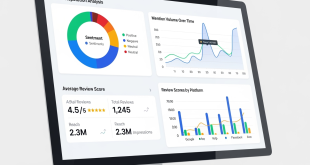Artificial Intelligence, or AI as it is colloquially known, is increasingly leaving behind academic settings to make inroads into the practical world of business.
Many industries are increasingly relying upon machine learning and assorted tools to provide services not possible with traditional computing – or perhaps even human – capabilities.

While many of these applications are very tech intensive, requiring significant investment and technical knowhow to be really effective, there is one low hanging fruit that even small businesses can take advantage of – chatbots.
What are chatbots and why should you use them?
Let’s find out.
An Introduction to Chatbots
Chatbots are basically AI software applications that can simulate natural human conversation over a messaging or texting app.
This makes them the perfect choice for supplementing – if not outright replacing – your customer support operations.
Developed by a programming technique called machine learning, chatbots learn human speech patterns and grammatical rules by analyzing reams of conversation logs and related data and understanding the underlying structure to them.
This does not mean they can completely replace human conversation, however.
Chatbots, while very
flexible, are only somewhat better than canned responses, and do not perform
that well when faced with unforeseen questions or circumstances.
The Advantages of a Chatbot
No matter what kind of business you run, you ultimately need to implement customer support as well.
Users always have queries and complaints, and proper handling of these things is what differentiates a company with a positive brand image from one without.
Now, the traditional customer support operation relies on dedicated executives reaching out through voice and chat.
In recent years, however, there has been a steady movement toward exclusive chat support, or at least giving more preference to it.
And the reason for this shift?
Chatbots.
Chatbots Can Solve Simple Issues Without Human Help
Chatbots can adequately handle a vast majority of consumer queries and offer proper resolutions, once properly ‘trained’ using the past corpus of archived chats.
This is because most of the questions asked are rather straightforward, and repetitive in nature, which is also why FAQs work so well.
A problem that has come up to a particular user now has likely come up before, and the previous responses – properly phrased to the context of the current conversation – will likely solve it once again.
This simple fact means that chatbots excel in customer support roles, dealing with a large number of requests with a lot more tact and professionalism than a full fledged customer support team.
Chatbots Improve Scalability
This is the biggest benefit of migrating to a chatbot customer support framework.
Traditional support operations struggle with the issues of scale; how does your small in-house team that worked perfectly with your regular number of queries suddenly deal with the abrupt jump in the volume of complaints as the festive season rolls in?
Going for a thousand fold increase in your employee numbers is hardly worth it for a temporary phase, but just winging it is not an option either.
These high sales periods are critical for the revenue stream of any company, and the profits made here are often what keeps them afloat throughout the rest of the year.
This is where chatbots come in; since the bulk of the queries can be handled by automated chatbots, your human team only has to focus on the more difficult problems, which is likely to be a small fraction of all requests that come in.
Moreover, chatbots can perform the same service just as fast at any volume, which means none of your customers are kept waiting for an executive to get back.
This translates to more satisfied customers, which in turn means much better reviews of your company.
Cost Savings
This angle is obvious.
As a large number of your customer inquiries are going to be handled by automated systems, only a rare few will make it to your actual customer support team, which means you need fewer people on the payroll.
Make no mistake, however, that these few people will need to be problem solvers at the top of their game.
The reason?
Only the most complicated queries will make it past a well-programmed chatbot.
Even tried and tested products have enough convolutions and edge cases to throw even the most dedicated of individuals into a loop.
Very few people have problem-solving skills and creativity to crack tough problems.
For example, look
for those who solve PC issues on their own and are not afraid to look for more
efficient ways to do things. These are the people you want to hire to
supplement your chatbot support system.
How to Get a Chatbot
Singing praises is well and good, but how do you go about getting a loyal, world-conquering chatbot of your own?
Except for the world-conquering part, I suppose.
There are quite a few ways.
The traditional method would be to get your own in-house development team to create a chatbot of your own.
But this option is hardly suitable for small businesses; you are unlikely to have tens and thousands of chats and conversations to draw upon for training the data models, or – let’s face it – the required level of technical knowhow.

Artificial Intelligence is a rather involved field and is best handled by experts. Which brings us to the second option: contract an IT services company to build a custom chatbot for you.
This is not a bad option and is actually how most of the mid-level companies get their chatbot systems in place.
It has the advantage of being a solution that is tailor-made for your particular use case and specifications, which would make it much easier to use.
But this too, is not that great an option for small businesses, for a single issue – it tends to be rather expensive. A custom built chatbot can set you back by $40,000 to $100,000, which is only profitable for the top tier companies.
The third and best option for small enterprises are off-the-shelf products that can be repurposed for particular use cases.
Examples of this
include services like haptik,
which provide pre-built customer support bots that can be swiftly adapted into
your workflow for immediate results.
Conclusion
Chatbots are one of the easiest AI based tools to leverage.
For a small initial setup and investment, you can increase the efficiency of your customer support operations drastically, cutting back costs and improving the customer experience at the same time.
The industry is already moving towards integrating modern innovations like chatbots into their customer support networks.
Don’t get left behind.
–
Lisa Michaels is a freelance writer, editor and a thriving marketing consultant from Portland. She takes care of the content for one of the biggest utility software providers, Solvusoft. Thanks to her tech knowledge, she creates articles and guides that help users tackle common Windows software issues. Feel free to connect with her on Twitter @LisaBMichaels.
 Entrepreneur Resources Your source for small business information
Entrepreneur Resources Your source for small business information





Hello, I had a great time reading your article. This is very informative. Using chatbot is very important for me. I believe this will be a big help to many people online. Thank you very much for sharing this. Have a good day.
– Jedd